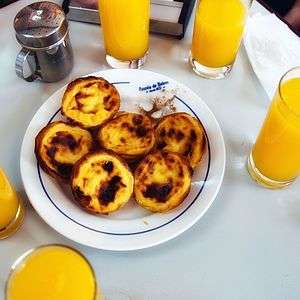Pastel de nata
Pastel de nata (Portuguese pronunciation: [pɐʃˈtɛɫ dɨ ˈnatɐ] (plural: pastéis de nata) is a Portuguese egg tart pastry dusted with cinnamon.[1] Outside Portugal, they are particularly popular in other parts of Western Europe, Asia and former Portuguese colonies, such as Brazil and Macau. The Macanese Pastel de nata was also adopted by KFC and is available in countries such as mainland China and Taiwan. In Indonesia, this pastry is also quite popular, especially in Kampung Tugu (Jakarta), an ethnic Portuguese (Mardijker) enclave.[2]
 The typical appearance of the pastel de nata in Lisbon, Portugal | |
| Alternative names | Pastel de Belém Pastries of Bethlehem 葡撻 (Cantonese) |
|---|---|
| Course | Dessert |
| Place of origin | Portugal |
| Region or state | Saint Mary of Bethlehem, Lisbon (originally); produced worldwide within the Lusosphere |
| Created by | Religious of the Monastery of the Hieronymites |
| Serving temperature | Fresh from oven, with cinnamon and icing sugar |
| Main ingredients | Egg yolks |
| Variations | egg tart, custard tart |
| ca. 300 per 100 grams (3.5 oz) kcal | |
History
The pastéis de nata were created before the 18th century by Catholic monks at the Hieronymites Monastery (Portuguese: Mosteiro dos Jerónimos) in the civil parish of Saint Mary of Bethlehem, in Lisbon.[3][4] At the time, convents and monasteries used large quantities of egg-whites for starching clothes, such as friars and nuns' religious habits. It was quite common for monasteries and convents to use the leftover egg yolks to make cakes and pastries, resulting in the proliferation of sweet pastry recipes throughout the country.
Following the extinction of the religious orders and in the face of the impending closure of many of the convents and monasteries in the aftermath of the Liberal Revolution of 1820, the monks started selling pastéis de nata at a nearby sugar refinery to bring in some revenue. In 1834, the monastery was closed and the recipe was sold to the sugar refinery, whose owners in 1837 opened the Fábrica de Pastéis de Belém. The descendants own the business to this day.[5]
In 2009 The Guardian listed pastéis de Belém as one of the 50 "best things to eat" in the world.[6]
Japanese cuisine
The cuisine of Japan was heavily influenced by Portuguese traders during the 16th century. Notable Japanese baked goods including pan (パン), called pão in Portuguese, and castella have their origins in this period. Pastel de nata is one of these.[7] In addition to the traditional form of the pastry, some variations have been developed especially for the Japanese market by adding green tea flavoring. This green tea pastel de nata was eventually exported to South Korea and other Asian markets.[8]
See also
References
- Citations
- Julian Baggini (18 February 2015). "Custard tart fight: can the British version ever compete with Portugal's pastéis de nata?". The Guardian.
- "3 KUDAPAN KHAS JAKARTA HASIL AKULTURASI BUDAYA". infobudaya.net (in Indonesian). 2017-09-18.
- Pastéis de nata were created before the 18th century by Catholic monks at the Jerónimos Monastery (Portuguese: Mosteiro dos Jerónimos)
- Santos, Nina. "A Brief Introduction to Pastel De Nata, Portuguese Custard Tarts". Culture Trip. Retrieved November 12, 2019.
- "175 anos de pastéis de Belém [175 years of pasteléis de Belém]". Correio da Manhã (in Portuguese). 12 August 2012. Retrieved June 6, 2018.
- Fox, Killian (13 September 2009). "The 50 best things to eat in the world, and where to eat them (The Guardian)". London.
- Swinnerton, Robbie (5 September 2009). "Take a little bite of Portugal's egg tart". London.
- Verbeke, Alain (ed.). Distance in International Business: Concept, Cost and Value.
- Sources
- Merle, Dominick (11 August 2004), "There's history - and a secret - in every bite", The Christian Science Monitor, retrieved 23 April 2012
- Amaral, André; Pires, Carla; Castro e Silva, Daniel; Medeiros, Luís; André, Mário Rui (December 2011), O Segredo do Marketing dos Pastéis de Belém (in Portuguese), Lisbon, Portugal: Escola Superior de Comunicação Social, Instituto Politécnico de Lisboa, archived from the original (PDF) on 2013
External links
![]()